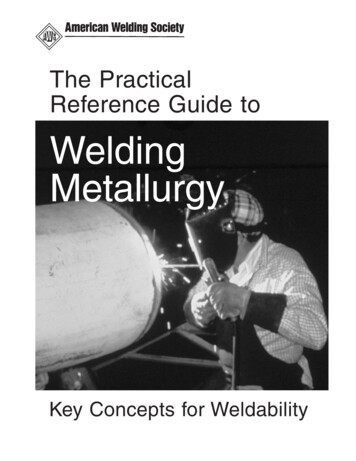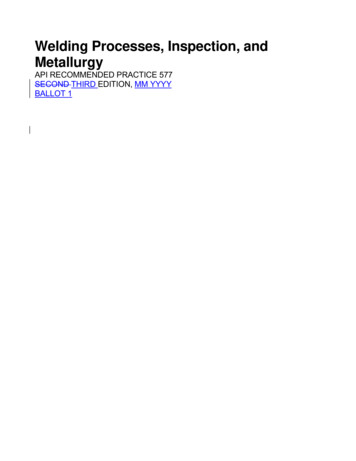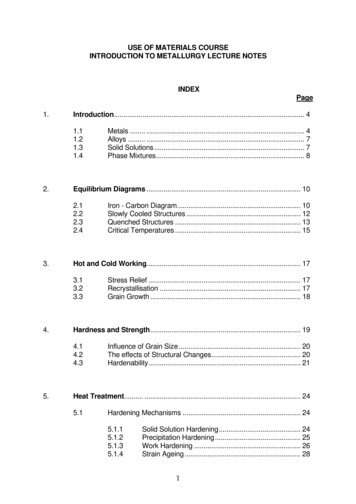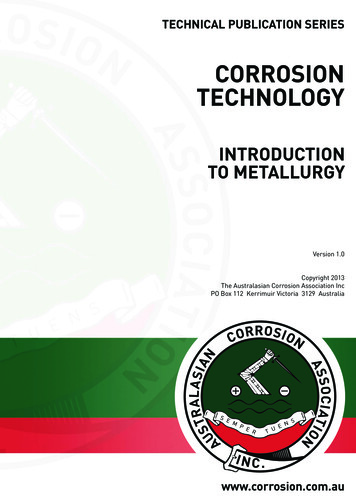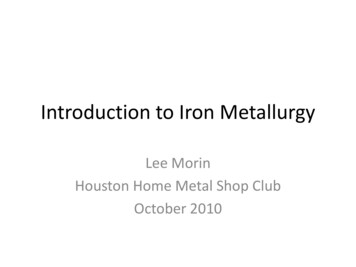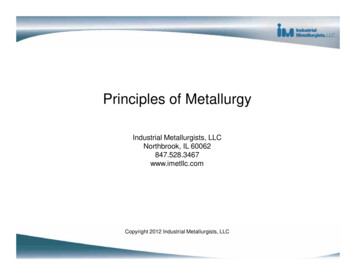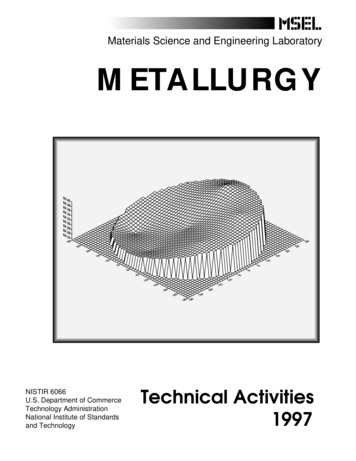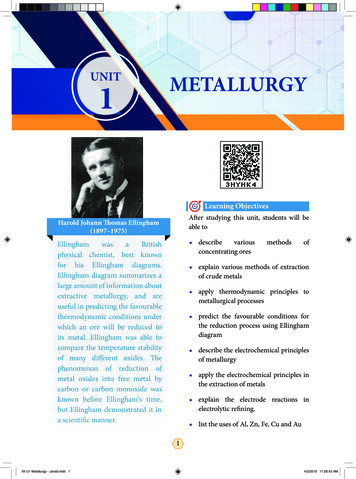
Transcription
UNITMETALLURGY1Learning ObjectivesAfter studying this unit, students will beable toHarold Johann Thomas Ellingham(1897–1975)EllinghamwasaBritishphysical chemist, best knownfor his Ellingham diagrams.Ellingham diagram summarizes alarge amount of information aboutextractive metallurgy, and areuseful in predicting the favourablethermodynamic conditions underwhich an ore will be reduced toits metal. Ellingham was able tocompare the temperature stabilityof many different oxides. Thephenomenon of reduction ofmetal oxides into free metal bycarbon or carbon monoxide wasknown before Ellingham's time,but Ellingham demonstrated it ina scientific manner. describevariousconcentrating oresmethodsofexplain various methods of extractionof crude metalsapply thermodynamic principles tometallurgical processespredict the favourable conditions forthe reduction process using Ellinghamdiagramdescribe the electrochemical principlesof metallurgyapply the electrochemical principles inthe extraction of metalsexplain the electrode reactions inelectrolytic refining.list the uses of Al, Zn, Fe, Cu and Au1Untouchability is Inhuman and a CrimeXII U1 Metallurgy - Jerald.indd 14/2/2019 11:26:53 AM
INTRODUCTIONMetallurgy relate to the science and technology of metals. In nature, only a few metalsoccur in their native state, all other metals occur in a combined state as their oxides,sulphides, silicates etc. The extraction of pure metals from their natural sources, is linkedto the history of human civilisation. Ancient people used the available materials in theirenvironment which includes fire and metals, and they were limited to the metals availableon the earth's surface. In the modern world, we use a wide range of metals in our daily life,which is the result of the development of metallurgical knowledge over thousands of years.Our need for the materials with specific properties have led to production of many metalalloys. It is essential to design an eco-friendly metallurgical process that would minimizewaste, maximize energy efficiency. Such advances in metallurgy is vital for the economicand technical progress in the current era. In this unit we will study the various stepsinvolved in the extraction of metals and the chemical principles behind these processes.1.1 Occurrence of metalsIn general, pure metals are shiny and malleable, however, most of them are found innature as compounds with different properties. Metals having least chemical reactivitysuch as copper, silver, gold and platinum occur in significant amounts as native elements.Reactive metals such as alkali metals usually occurs in their combined state and areextracted using suitable metallurgical process.1.1.1 Mineral and oreA naturally occurring substance obtained by mining which contains the metal in freestate or in the form of compounds like oxides, sulphides etc. is called a mineral. Inmost of the minerals, the metal of interest is present only in small amounts and some ofthem contains a reasonable percentage of metal. For example iron is present in around800 minerals. However, some of them such as hematite magnetite etc., containing highpercentage of iron are commonly used for the extraction of iron. Such minerals thatcontains a high percentage of metal, from which it can be extracted conveniently andeconomically are called ores. Hence all ores are minerals but all minerals are not ores. Letus consider another example, bauxite and china clay (Al2O3.SiO2.2H2O). Both are mineralsof aluminium. However, aluminium can be commercially extracted from bauxite whileextraction from china clay is not a profitable one. Hence the mineral, bauxite is an ore ofaluminium while china clay is not.The extraction of a metal of interest fromits ore consists of the following metallurgicalprocesses.(i) concentration of the ore(ii) extraction of crude metal(iii) refining of crude metalMalachite – copper mineral2Untouchability is Inhuman and a CrimeXII U1 Metallurgy - Jerald.indd 24/2/2019 11:26:53 AM
Table 1.1 List of some metals and their common ores with their chemical sitionZinc blende O4SideriteFeCO3CerrusitePbCO3Iron pyriteFeS2LimoniteFe2O3.3H2OCopper pyriteCuFeS2Copper cLeadTinSilverCassiterite(Tin stone)Silver glance(Argentite)Pyrargyrite(Ruby silver)Chlorargyrite(Horn Silver)SnO2Ag2SAg3SbS3AgCl1.2 Concentration of oresGenerally, the ores are associated with nonmetallic impurities, rocky materials and siliceousmatter which are collectively known as gangue. The preliminary step in metallurgical process isremoval of these impurities. This removal process is known as concentration of ore. It increases theconcentration of the metal of interest or its compound in the ore. Several methods are available forthis process and the choice of method will depend on the nature of the ore, type of impurity andenvironmental factors. Some of the common methods of ore concentration are discussed below.1.2.1 Gravity separation or Hydraulic washIn this method, the ore having high specific gravity is separated from the gangue that haslow specific gravity by simply washing with running water. Ore is crushed to a finely powderedform and treated with rapidly flowing current of water. During this process the lighter gangueparticles are washed away by the running water. This method is generally applied to concentratethe native ore such as gold and oxide ores such as haematite (Fe2O3), tin stone (SnO2) etc.3Untouchability is Inhuman and a CrimeXII U1 Metallurgy - Jerald.indd 34/2/2019 11:26:53 AM
1.2.2 Froth flotationThis method is commonly used to concentrate sulphide ores such as galena (PbS), zincblende (ZnS) etc. In this method, the metallic ore particles which are preferentially wetted byoil can be separated from gangue.In this method, the crushedore is suspended in water andmixed with frothing agent suchmotoras pine oil, eucalyptus oil etc.controllerA small quantity of sodiumethyl xanthate which acts asair supplyfroth concena collector is also added. Alayertratefroth is generated by blowingair through this mixture. Thefeedcollector molecules attach tovalvethe ore particle and make themsensorwater repellent. As a result, oreparticles, wetted by the oil, risestirrertailingsto the surface along with thefroth. The froth is skimmedoff and dried to recover theFigure 1.1 Froth Flotationconcentrated ore. The gangueparticles that are preferentiallywetted by water settle at the bottom.When a sulphide ore of a metal of interest contains other metal sulphides as impurities,depressing agents such as sodium cyanide, sodium carbonate etc are used to selectivelyprevent other metal sulphides from coming to the froth. For example, when impuritiessuch as ZnS is present in galena (PbS), sodium cyanide (NaCN) is added to depresses theflotation property of ZnS by forming a layer of zinc complex Na2[Zn(CN)4] on the surfaceof zinc sulphide.1.2.3 LeachingThis method is based on the solubility of the ore in a suitable solvent and the reactionsin aqueous solution. In this method, the crushed ore is allowed to dissolve in a suitablesolvent, the metal present in the ore is converted to its soluble salt or complex while thegangue remains insoluble. The following examples illustrate the leaching processes.Cyanide leachingLet us consider the concentration of gold ore as an example. The crushed ore ofgold is leached with aerated dilute solution of sodium cyanide. Gold is converted into asoluble cyanide complex. The gangue, aluminosilicate remains insoluble.4Au (s) 8CN (aq) O2 (g) 2H2O (l)4[Au(CN)2] (aq) 4OH (aq)4Untouchability is Inhuman and a CrimeXII U1 Metallurgy - Jerald.indd 44/2/2019 11:26:55 AM
Recovery of metal of interest from the complex by reduction:Gold can be recovered by reacting the deoxygenated leached solution with zinc. In thisprocess the gold is reduced to its elemental state (zero oxidation sate) and the process is calledcementation.[Zn(CN)4]2 (aq) 2Au (s)Zn (s) 2[Au(CN)2] (aq)Ammonia leachingWhen a crushed ore containing nickel, copper and cobalt is treated withaqueous ammonia under suitable pressure, ammonia selectively leaches these metals byforming their soluble complexes viz. [Ni(NH3)6]2 , [Cu(NH3)4]2 , and [Co(NH 3)5H2O]3 respectively from the ore leaving behind the gangue, iron(III) oxides/hydroxides andaluminosilicate.Alkali leachingIn this method, the ore is treated with aqueous alkali to form a soluble complex.For example, bauxite, an important ore of aluminum is heated with a solution of sodiumhydroxde or sodium carbonate in the temperature range 470 - 520 K at 35 atm to formsoluble sodium meta-aluminate leaving behind the impurities, iron oxide and titaniumoxide.Al2O3 (s) 2NaOH (aq) 3H2O (l)2Na[Al(OH)4] (aq)The hot solution is decanted, cooled, and diluted. This solution is neutralised by passingCO2 gas, to the form hydrated Al2O3 precipitate.2Na[Al(OH)4] (aq) CO2 (g)Al2O3.xH2O (s) 2NaHCO3 (aq)The precipitate is filtered off and heated around 1670 K to get pure alumina Al2O3.Acid leachingLeaching of sulphide ores such as ZnS, PbS etc., can be done by treating them with hotaqueous sulphuric acid.2ZnSO4 (aq) 2S (s) H2O2ZnS (s) 2H2SO4 (aq) O2(g)In this process the insoluble sulphide is converted into soluble sulphate and elemental sulphur.Evaluate yourself 11. Write the equation for the extraction of silver by leaching with sodium cyanide andshow that the leaching process is a redox reaction.5Untouchability is Inhuman and a CrimeXII U1 Metallurgy - Jerald.indd 54/2/2019 11:26:56 AM
1.2.4 Magnetic separationThis methodisapplicabletoferromagneticoresand it is based onPowderedwderedorethe difference in themagnetic propertiesof the ore and theMagneticimpurities.ForWheelexample tin stone canbe separated from theMoving beltwolframite impuritiesMagneticwhich is magnetic.oreNon-MagneticSimilarly, ores such asorechromite, pyrolusiteFigure 1.2 Magnetic separationhavingmagneticpropertycanberemoved from thenon magnetic siliceous impurities. The crushed ore is poured on to an electromagneticseparator consisting of a belt moving over two rollers of which one is magnetic. Themagnetic part of the ore is attracted towards the magnet and falls as a heap close to themagnetic region while the nonmagnetic part falls away from it as shown in the figure 1.2.1.3 Extraction of crude metalThe extraction of crude metals from the concentrated ores is carried out in two stepsnamely, (i) conversion of the ore into oxides of the metal of interest and (ii) reduction of themetal oxides to elemental metals. In the concentrated ore, the metal exists in positive oxidationstate and hence it is to be reduced to its elemental state. We can infer from the principles ofthermodynamics, that the reduction of oxide is easier when compared to reduction of othercompounds of metal and hence, before reduction, the ore is first converted into the oxide ofmetal of interest.Let us discuss some of the common methods used to convert the concentrated ore into theoxides of the metal of interest.1.3.1 Conversion of ores into oxidesRoastingRoasting is the method, usually applied for the conversion of sulphide ores into theiroxides. In this method, the concentrated ore is oxidised by heating it with excess of oxygen ina suitable furnace below the melting point of the metal.6Untouchability is Inhuman and a CrimeXII U1 Metallurgy - Jerald.indd 64/2/2019 11:26:56 AM
2PbS 3O2 2PbO 2SO22ZnS 3O2 2ZnO 2SO22Cu2S 3O22Cu2O 2SO2Roasting also removes impurities such as arsenic, sulphur, phosphorous by convertingthem into their volatile oxides.For example4As 3O22As2O3S8 8O28SO2P4 5O2P4O10The sulphur dioxide produced during roasting process is harmful to theenvironment. In modern metallurgical factories, this by product is trappedand converted into sulphuric acid to avoid air pollution.CalcinationCalcination is the process in which the concentrated ore is strongly heated in the absenceof air. During this process, the water of crystallisation present in the hydrated oxide escapes asmoisture. Any organic matter (if present) also get expelled leaving behind a porous ore. Thismethod can also be carried out with a limited supply of air.For examples,During calcination of carbonate ore, carbon dioxide is expelledPbCO3 PbO CO2CaCO3ZnCO3MgCO3.CaCO3CaO CO2 ZnO CO2 MgO CaO 2CO2During calcination of hydrated ore, the water of hydration is expelled as vapour7Untouchability is Inhuman and a CrimeXII U1 Metallurgy - Jerald.indd 74/2/2019 11:26:56 AM
Fe2O3.3H2O Fe2O3 (s) 3H2O (g)Al2O3.2H2O Al2O3 (s) 2H2O (g)Evaluate yourself 22. Magnesite (Magnesium carbonate) is calcined to obtain magnesia, which is used tomake refractory bricks. Write the decomposition reaction.1.3.2 Reduction of metal oxidesMetal oxide can be reduced to crude metal by using a suitable reducing agent like carbon,carbon monoxide, hydrogen, aluminium and other reactive metals such as sodium etc.Thechoice of reducing agent depends on the nature of the metal. For example, carbon cannotbe used as a reducing agent for the reactive metals such as sodium, potassium, aluminiumetc.Similarly CO cannot be used to reduce oxides such as ZnO, Al2O3. Later in this,we studyselection of suitable reducing agents by applying Ellingham diagram.SmeltingIn this method, a flux (a chemical substance that forms an easily fusible slag with gangue)and a reducing agent such as carbon, carbon monoxide (or) aluminium is added to theconcentrated ore and the mixture is melted by heating at an elevated temperature (above themelting point of the metal) in a smelting furnace. For example the oxide of iron can be reducedby carbon monoxide as follows.Fe2O3 (s) 3CO (g)2Fe (s) 3CO2 (g)In this extraction, a basic flux, limestone (CaO) is used. Since the silica gangue present inthe ore is acidic in nature, the limestone combines with it to form calcium silicate (slag).CaSiO3 (s)CaO (s) SiO2 (s)FluxGangueSlagIn the extraction of copper from copper pyrites, the concentrated ore is heated in areverberatory furnace after mixing with silica, an acidic flux. The ferrous oxide formed dueto melting is basic in nature and it combines with silica to form ferrous silicate (slag). Theremaining metal sulphides Cu2S and FeS are mutually soluble and form a copper matte.2CuFeS2 (s) O2 (g)2FeS (l) Cu2S (l) SO2 (g)2FeS (l) 3O2 (g)2FeO (l) 2SO2 (g)FeO (s) SiO2 (s)FluxFeSiO3 (s)GangueSlag8Untouchability is Inhuman and a CrimeXII U1 Metallurgy - Jerald.indd 84/2/2019 11:26:57 AM
The matte is separated from the slag and fed to the converting furnace. During conversion,the FeS present in the matte is first oxidised to FeO. This is removed by slag formation withsilica. The remaining copper sulphide is further oxidised to its oxide which is subsequentlyconverted to metallic copper as shown below.2Cu2S (l,s) 3O2 (g)2Cu2O (l,s) 2SO2 (g)2Cu2O (l) Cu2S (l)6Cu (l) SO2 (g)The metallic copper is solidified and it has blistered appearance due to evolution of SO2gas formed in this process. This copper is called blistered copper.Reduction by carbon:In this method the oxide ore of the metal is mixed with coal (coke) and heated strongly ina furnace (usually in a blast furnace). This process can be applied to the metals which do notform carbides with carbon at the reduction temperature.Examples:ZnO (s) C (s)Zn (s) CO (g)Mn3O4 (s) 4C (s)3Mn (s) 4CO (g)Cr2O3 (s) 3C (s)2Cr (s) 3CO (g)Reduction by hydrogen:This method can be applied to the oxides of the metals (Fe, Pb, Cu) having less electropositive character than hydrogen.Ag2O (s) H2 (g)2Ag (s) H2O (l)Fe3O4 (s) 4H2 (g)3Fe (s) 4H2O (l)Nickel oxide can be reduced to nickel by using a mixture of hydrogen and carbon monoxide(water gas)2NiO (s) CO (g) H2 (g)2Ni (s) CO2 (g) H2O (l)Reduction by metal:Metallic oxides such as Cr2O3 can be reduced by an aluminothermite process. In thisprocess, the metal oxide is mixed with aluminium powder and placed in a fire clay crucible. Toinitiate the reduction process, an ignition mixture (usually magneisium and barium peroxide)is used.9Untouchability is Inhuman and a CrimeXII U1 Metallurgy - Jerald.indd 94/2/2019 11:26:57 AM
BaO2 MgBaO MgODuring the above reaction a large amount of heat is evolved (temperature up to 2400 C, isgenerated and the reaction enthalpy is : 852 kJ mol-1) which facilitates the reduction of Cr2O3by aluminium power.Cr2O3 2AlΔ2Cr Al2O3Active metals such as sodium, potassium and calcium can also be used to reduce themetal oxideB2O3 6Na2B 3Na2ORb2O3 3Mg2Rb 3MgOTiO2 2MgTi 2MgOThO2 2Ca1250 KTh 3CaOAuto-reduction:Simple roasting of some of the ores give the crude metal. In such cases, the use ofreducing agents is not necessary. For example, mercury is obtained by roasting of its orecinnabar (HgS)HgS (s) O2 (g)1.4Hg (l) SO2Thermodynamic principle of metallurgyAs we discussed, the extraction of metals from their oxides can be carried out by usingdifferent reducing agents. For example, consider the reduction of a metal oxide MxO y.2yMxOy (s)2xyM (s) O2 (g) ------ (1)The above reduction may be carried out with carbon. In this case, the reducing agentcarbon may be oxidised to either CO or CO2.C O2CO2 (g) ------ (2)2C O22CO (g) ------ (3)If carbon monoxide is used as a reducing agent, it is oxidised to CO2 as follows,2CO O22CO2 (g) ------ (4)A suitable reducing agent is selected based on the thermodynamic considerations. Weknow that for a spontaneous reaction, the change in free energy (ΔG) should be negative.Therefore, thermodynamically, the reduction of metal oxide [equation (1)] with a given10Untouchability is Inhuman and a CrimeXII U1 Metallurgy - Jerald.indd 104/2/2019 11:26:58 AM
reducing agent [Equation (2), (3) or (4)] can occur if the free energy change for the coupledreaction. [Equations (1) & (2), (1) & (3) or (1) & (4)] is negative. Hence, the reducing agentis selected in such a way that it provides a large negative ΔG value for the coupled reaction.1.4.1 Ellingham diagram20010004Ag –1002HO2–2004Cu u 2O2CO2 i 2NONiO 222FeO Fe O 22–400–1G RT Inp O2 / kJmol O2–300O2Ag 2OHg 22 g O2–5002Zn OZnO 22–600r4/3C2Mn O2C O2 CO2CrO 33 2/nO2MO2 2C –700–800Al 4/3–900–1000–1100a2CgOg2M O2O2 O2 2COl 2O 3A2/3 OOCa 22m 200T / CFigure 1.4 Ellingham diagram11Untouchability is Inhuman and a CrimeXII U1 Metallurgy - Jerald.indd 114/2/2019 11:26:58 AM
The change in Gibbs free energy (ΔG) for a reaction is given by the expression.ΔG ΔH - TΔS ------ (1)where, ΔH is the enthalpy change , T the temperature in kelvin and ΔS the entropychange. For an equilibrium process, ΔG⁰ can be calculated using the equilibrium constant bythe following expressionΔG⁰ -RT lnKpHarold Ellingham used the above relationship to calculate the ΔG⁰ values at varioustemperatures for the reduction of metal oxides by treating the reduction as an equilibriumprocess.He has drawn a plot by considering the temperature in the x-axis and the standard freeenergy change for the formation of metal oxide in y-axis. The resultant plot is a straight line withΔS as slope and ΔH as y-intercept. The graphical representation of variation of the standardGibbs free energy of reaction for the formation of various metal oxides with temperature iscalled Ellingham diagramObservations from the Ellingham diagram.1. For most of the metal oxide formation, the slope is positive. It can be explained as follows.Oxygen gas is consumed during the formation of metal oxides which results in the decreasein randomness. Hence, ΔS becomes negative and it makes the term, TΔS positive in thestraight line equation.2. The graph for the formation of carbon monoxide is a straight line with negative slope. Inthis case ΔS is positive as 2 moles of CO gas is formed by the consumption of one mole ofoxygen gas. It indicates that CO is more stable at higher temperature.3. As the temperature increases, generally ΔG value for the formation of the metal oxidebecome less negative and becomes zero at a particular temperature. Below this temperature,ΔG is negative and the oxide is stable and above this temperature ΔG is positive. Thisgeneral trend suggests that metal oxides become less stable at higher temperature and theirdecomposition becomes easier.4. There is a sudden change in the slope at a particular temperature for some metal oxides likeMgO, HgO. This is due to the phase transition (melting or evaporation).1.4.2 Applications of the Ellingham diagram:Ellingham diagram helps us to select a suitable reducing agent and appropriate temperaturerange for reduction. The reduction of a metal oxide to its metal can be considered as acompetition between the element used for reduction and the metal to combine with oxygen.If the metal oxide is more stable, then oxygen remains with the metal and if the oxide ofelement used for reduction is more stable, then the oxygen from the metal oxide combineswith elements used for the reduction. From the Ellingham diagram, we can infer the relativestability of different metal oxides at a given temperature.12Untouchability is Inhuman and a CrimeXII U1 Metallurgy - Jerald.indd 124/2/2019 11:26:58 AM
1. Ellingham diagram for the formation of Ag2O and HgO is at upper part of the diagram andtheir decomposition temperatures are 600 and 700 K respectively. It indicates that theseoxides are unstable at moderate temperatures and will decompose on heating even in theabsence of a reducing agent.2. Ellingham diagram is used to predict thermodynamic feasibility of reduction of oxidesof one metal by another metal. Any metal can reduce the oxides of other metals that arelocated above it in the diagram. For example, in the Ellignham diagram, for the formationof chromium oxide lies above that of the aluminium, meaning that Al2O3 is more stablethan Cr2O3. Hence aluminium can be used as a reducing agent for the reduction of chromicoxide. However, it cannot be used to reduce the oxides of magnesium and calcium whichoccupy lower position than aluminium oxide.3. The carbon line cuts across the lines of many metal oxides and hence it can reduce allthose metal oxides at sufficiently high temperature. Let us analyse the thermodynamicallyfavourable conditions for the reduction of iron oxide by carbon. Ellingham diagram for theformation of FeO and CO intersects around 1000 K. Below this temperature the carbonline lies above the iron line which indicates that FeO is more stable than CO and henceat this temperature range, the reduction is not thermodynamically feasible. However,above 1000 K carbon line lies below the iron line and hence, we can use coke as reducingagent above this temperature. The following free energy calculation also confirm that thereduction is thermodynamically favoured.From the Ellingham Diagram at 1500 K,2Fe (s) O2 (g)2FeO (g)ΔG1 -350 kJ mol–1 ------ (5)2C (s) O2 (g)2CO (g)ΔG2 -480 kJ mol–1------ (6)Reverse the reaction (1)2FeO (s)2Fe (s) O2 (g) – ΔG1 350 kJ mol–1 ------ (5)Now couple the reactions (2) and (3)2FeO (s) 2C2Fe (l,s) 2CO (g) ΔG3 -130 kJ mol–1 ------ (8)The standard free energy change for the reduction of one mole of FeO is, ΔG3/2 -65 kJ mol-1Limitations of Ellingham diagram1. Ellingham diagram is constructed based only on thermodynamic considerations. It givesinformation about the thermodynamic feasibility of a reaction. It does not tell anythingabout the rate of the reaction. More over, it does not give any idea about the possibility ofother reactions that might be taking place.2. The interpretation of ΔG is based on the assumption that the reactants are in equilibriumwith the products which is not always true.13Untouchability is Inhuman and a CrimeXII U1 Metallurgy - Jerald.indd 134/2/2019 11:26:59 AM
Evaluate yourself 33. Using Ellingham diagram (fig 1.4) indicate the lowest temperature at which ZnOcan be reduced to Zinc metal by carbon. Write the overall reduction reaction at thistemperature.1.5 Electrochemical principle of metallurgySimilar to thermodynamic principles, electrochemical principles also find applicationsin metallurgical process. The reduction of oxides of active metals such as sodium, potassiumetc., by carbon is thermodynamically not feasible. Such metals are extracted from their oresby using electrochemical methods. In this technique, the metal salts are taken in a fused formor in solution form. The metal ion present can be reduced by treating it with some suitablereducing agent or by electrolysis.Gibbs free energy change for the electrolysis process is given by the following expressionΔG -nFE Where n is number of electrons involved in the reduction process, F is the Faraday and E0is the electrode potential of the redox couple.If E0 is positive then the ΔG is negative and the reduction is spontaneous and hence aredox reaction is planned in such a way that the e.m.f of the net redox reaction is positive.When a more reactive metal is added to the solution containing the relatively less reactivemetal ions, the more reactive metal will go into the solution. For example,Cu (s) 2Ag (s)Cu 2 (aq) 2Ag (s)Cu2 (aq) Zn (s)Cu (s) Zn 2 (aq)1.5.1 Electrochemial extraction of aluminium - Hall-Herold process:In this method, electrolysis is carried out in an iron tank lined with carbon which actsas a cathode. The carbon blocks immersed in the electrolyte act as a anode. A 20% solutionof alumina, obtained from the bauxite ore is mixed with molten cyrolite and is taken in theelectrolysis chamber. About 10% calcium chloride is also added to the solution. Here calciumchloride helps to lower the melting point of the mixture. The fused mixture is maintained at atemperature of above 1270 K. The chemical reactions involved in this process are as follows.Ionisaiton of aluminaAl2O3Reaction at cathode2Al3 (melt) 6eReaction at anode6O2- (melt)2Al3 3O2-2Al (l)-3O2 12eSince carbon acts as anode the following reaction also takes place on it.14Untouchability is Inhuman and a CrimeXII U1 Metallurgy - Jerald.indd 144/2/2019 11:26:59 AM
-C (s) O2- (melt)CO 2eC (s) 2O2- (melt)CO2 4eDue to the above two reactions, anodes are slowly consumed during the electrolysis. Thepure aluminium is formed at the cathode and settles at the bottom. The net electrolysis reactioncan be written as follows.4Al3 (melt) 6O2- (melt) 3C (s)4Al (l) 3CO2 (g)Evaluate yourself 44. Metallic sodium is extracted by the electrolysis of brine (aq. NaCl). After electrolysisthe electrolytic solution becomes basic in nature. Write the possible electrodereactions.1.6 Refining processGenerally the metal extracted from its ore contains some impurities such as unreactedoxide ore, other metals, nonmetals etc.Removal of such impurities associated with the isolatedcrude metal is called refining process. In this section, let us discuss some of the commonrefining methods.1.6.1 DistillationThis method is employed for low boiling volatile metals like zinc (boiling point 1180 K)and mercury (630 K). In this method, the impure metal is heated to evaporate and the vapoursare condensed to get pure metal.1.6.2 LiquationThis method, is employed to remove the impurities with high melting points from metalshaving relatively low melting points such as tin (Sb; mp 904 K), lead (Pb; mp 600 K), mercury(Hg; mp 234 K), and bismuth (Bi; mp 545 K). In this process, the crude metal is heated toform fusible liquid and allowed to flow on a sloping surface. The impure metal is placed onsloping hearth of a reverberatory furnace and it is heated just above the melting point of themetal in the absence of air, the molten pure metal flows down and the impurities are leftbehind. The molten metal is collected and solidified.1.6.3 Electrolytic refining:The crude metal is refined by electrolysis. It is carried out in an electrolytic cell containingaqueous solution of the salts of the metal of interest. The rods of impure metal are used asanode and thin strips of pure metal are used as cathode. The metal of interest dissolves fromthe anode, pass into the solution while the same amount of metal ions from the solution will bedeposited at the cathode. During electrolysis, the less electropositive impurities in the anode,settle down at the bottom and are removed as anode mud.15Untouchability is Inhuman and a CrimeXII U1 Metallurgy - Jerald.indd 154/2/2019 11:26:59 AM
Let us understand this process by considering electrolytic refining of silver as an example.Cathode: Pure silverAnode: Impure silver rodsElectrolyte: Acidified aqueous solution of silver nitrate.When a current is passed through the electrodes the following reactions will take placeReaction at anodeAg (s)Ag (aq) 1eReaction at cathode-Ag (aq) 1eAg (s)During electrolysis, at the anode the silver atoms lose electrons and enter the solution. Thepositively charged silver cations migrate towards the cathode and get discharged by gainingelectrons and deposited on the cathode. Other metals such as copper, zinc etc.,can also berefined by this process in a similar manner.1.6.4 Zone RefiningThis method is based on the principles of fractional crystallisation. When an impuremetal is melted and allowed to solidify, the impurities will prefer to be in the molten region. i.e.impurities are more soluble in the melt than in the solid state metal. In this process the impuremetal is taken in the form of a rod. One end of the rod is heated using a mobile inductionheater which results in melting of the metal on that portion of the rod. When the heater isslowly moved to the other end the pure metal crystallises while the impurities will move onto the adjacent molten zone formed du
INTRODUCTION Metallurgy relate to the science and technology of metals. In nature, only a few metals occur in their native state, all other metals occur in a combined state as their oxides, sulphides, silicates etc. The extraction of pure metals from their natural

